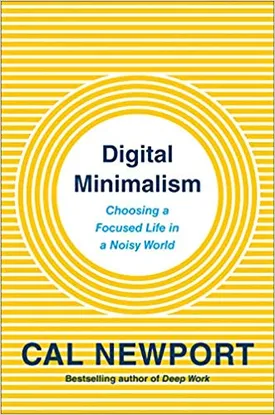Digital Minimalism: Choosing a Focused Life in a Noisy World by Cal Newport
Digital Minimalism: Choosing a Focused Life in a Noisy World is a book by author and professor Cal Newport that offers an alternative approach to technology use in the modern world. In this novel, Newport explains why he believes that the trend of “digital maximalism” – the use of technology to the point of obsession – is a mistake and provides an alternative perspective for how technology should be used.
The goal of Newport’s book is to explain how digital minimalism can support a meaningful life. Newport defines digital minimalism as “a philosophy of technology use in which you focus your online time on a small number of carefully selected and optimized activities that strongly support things you value, and then happily miss out on everything else.” The core foundations of digital minimalism includes being selective about which online activities to engage with and being proactive in controlling your online environment.
One of the key points of digital minimalism is the idea of using technology to improve the quality of life, rather than the quantity. Newport highlights that while digital maximalism seeks to maximize technology usage, this can only lead to more distraction and loss of focus. Digital minimalism, on the other hand, prioritizes activities that contribute to our well-being and meaningful experiences.
Newport also explains how digital minimalism is especially helpful for developing strong relationships with family and friends. We should focus on activities that help us build true connections, such as face-to-face conversations or meaningful hobbies. By doing this, we can create deeper bonds with our loved ones and strengthen our relationships.
The book also examines how digital minimalism can help us be more productive by giving us the space to focus on our work and the best moments of our lives. Newport explains the importance of having a set of guidelines that help structure our online activities, such as limiting our total time online, using digital calendars, and focusing on important tasks first. We should also understand that solid rest and “nuclear-option” strategies, in which technology use is avoided, are essential to creating an optimal environment for optimal productivity.
Finally, Newport argues that digital minimalism is ultimately more cost effective than digital maximalism. By optimizing our digital environment and focusing on essential activities, digital minimalism can help us enjoy a greater quality of life and be more productive with the time we do have online.
Overall, Digital Minimalism: Choosing a Focused Life in a Noisy World is an insightful and thought-provoking look at how technology can be used for our benefit. Through concrete advice and real-life examples, Newport provides a persuasive case for why digital minimalism is the best approach for making the most out of our lives. By following the core principles of this philosophy, we can create a more mindful, rewarding relationship with our technology.

